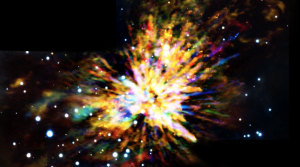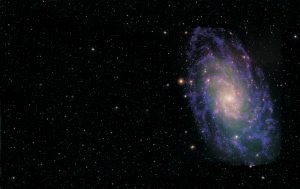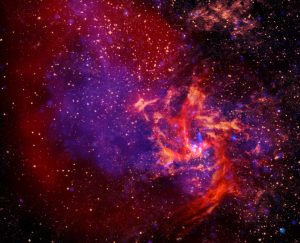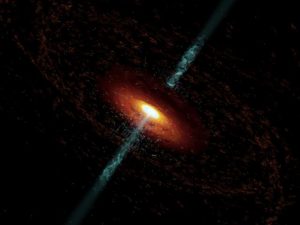This animation shows the motions of the gas streamers emanating from the OMC-1 star-forming region in Orion as seen with ALMA. The colors in the ALMA data represent the relative Doppler shifting of the millimeter-wavelength light emitted by carbon monoxide gas. Initially, the blue color in the ALMA data represents gas approaching at the highest speeds; the red color is from gas moving toward us more slowly. The video then briefly shows gas at rest with respect to the Orion clouds, followed by streamers receding on the other side with even greater speed. Finally, the animation blends into a near-infrared view from the Gemini South telescope showing shock waves produced by the explosion. The explosion occurred about 500 years ago when several young stars were ejected from the region.


The Triangulum Galaxy in Radio and Optical
Galaxies contain hundreds of billions of stars. They often group together in clusters, with a history of sharing and tearing their gases and dark matter. This is the Triangulum Galaxy, also known as M33. It is in the Local Group of galaxies, which includes the Andromeda Galaxy and our galaxy, the Milky Way. M33 is over thirty thousand light years across, and more than two million light years away. The optical data show the many stars within the galaxy as well as reddish star forming regions that are filled with hot Hydrogen gas. The radio data from the Very Large Array (VLA) represented in blue, reveal the cool Hydrogen gas within the galaxy, gas which cannot be seen with an optical telescope. Combined together, the radio and optical give a more comprehensive view of star formation in this galaxy.

Sagittarius A
The center of our Milky Way Galaxy is anchored by a black hole that is nearly 5 million times the mass of our Sun. Surrounding it is a chaotic city of stars, gas, and dust that we call Sagittarius A. We stacked false-color X-ray, infrared, and radio images into this single picture to show you the different structures hidden inside the core of our Galaxy. X-rays (purple) radiate from the super-hot gas trapped in the black hole’s grasp. The surrounding dust is heated by friction as it chaotically orbits around the black hole and then glows in infrared light (gold). And the enormous pools and three-armed rivers of gas shine in radio light (oranges and reds) to trace the complexity of magnetic fields in this violent neighborhood.

The supermassive black hole at the center of the Milky Way.
New evidence has been uncovered for the presence of a jet of high-energy particles blasting out of the Milky Way’s supermassive black hole known as Sagittarius A* (Sgr A*). This image of Sgr A* and the region around it contains radio emission data from the Very Large Array. Jets of high-energy particles are found throughout the Universe on large and small scales. The likely discovery of a jet from Sgr A* helps astronomers learn more about the giant black hole, including how it is spinning.

The Active Galactic Nucleus of 3C 120
Still image from an animation depicting the jets emitted by the black hole in galaxy 3C 120.

Milky Way-Like Galaxies in the Early Universe
Astronomers using ALMA have directly observed a pair of Milky Way-like galaxies seen as they appeared billions of years ago. These progenitors of today’s giant spiral galaxies are surrounded by “super halos” of hydrogen gas that extend many tens-of-thousands of light-years beyond their dusty, star-filled disks.





